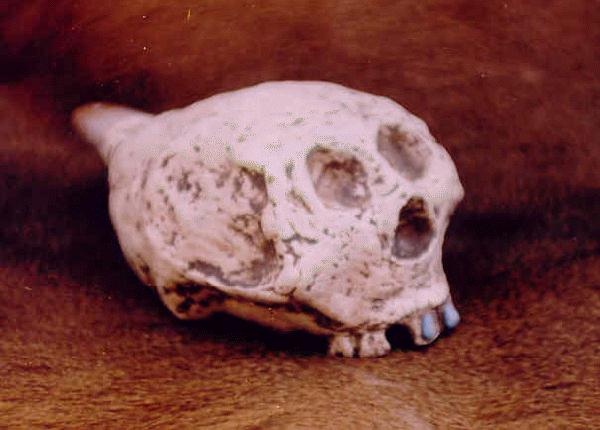Mayan aerophone of the death.

Clay model of a deformed cranium and a noise generator on a deer's skin.
Roberto Velázquez Cabrera
Virtual Research Institute Tlapitzcalzin
First version, May 1, 2003. Last version May 15, 2003.
The object of this exercise is to explore the recommendation included in a previous paper Mayan trumpets of Bonampak:
"Finally, there is a question about the possible relation between the special infrasounds effects in the cortex of the brain and the special oblique head shaping 1 and geometry (in the cortex) widely practiced in the pre-Hispanic time by the Mayans as it is shown in the mural of Bonampak and in diverse human figures on rock carvings of that zone. It could create a line of investigation for the new field of research ARCHAEOLOGY OF PEOPLE (as it is called by Dr. Vera Tiesler) and for other new field of research: ARCHAEOLOGY OF SOUNDS or ANCIENT ACOUSTICS and ANCIENT MUSICAL/SONOROUS ARTIFACTS (Sounding Instruments and Pre-Columbian Sounding Instruments Sessions), which already were included in the First Pan-American/Iberian Meeting on Acoustics, in Maya land..."
The experts on ancient cultures do not like to make acoustical experiments with old craniums, but some Mexican musician use models of craniums with "wind whistles" to make and to play "death whistles" in their performances, like Ernesto Olmos and his musical group Xaguia. It is possible that the shape of the Mayan craniums could affect the perception of some ancient sounds like the beats, because their physical vibrations are generated in the upper part of the brain in the cortex, but it is very difficult to make acoustical experiments with living deformed craniums. However, it was possible to make and to experiment with a clay model of a cranium used as a globular resonator and a noisy aerophone to analyze the generated sounds.
The experimental model was made with a Mexican noise/chaos generator or "aerophome of the death" decorated with a cranium in the exterior of their resonating chamber. Initially, those noisy aerophones were analyzed by some Mexican researchers like Jose Luis Franco2 and Guillermo Contreras3, but their references are very difficult to get like the old sonorous subjects of their studies (that are stored in museums and collections). However, their available organological-acoustical information is limited to some photos, drawings and possible ancient general uses and very short and general descriptions. The decoration with craniums suggest that those noisy aerophones were used in ceremonies or rites related with the death and they had been called "whistles of the death", that are members of the family of "aerophones of double diaphragm". The simple "mouth whistles" selected can produce complex non musical sounds with variations in pitch and timber, depending of the way of their excitation and the configuration of the mouth cavity.
The sounding mechanism of the noise generators can have several internal designs and may be played outside and inside the mouth of the performer, which means that the sounding mechanism and the resonating chamber can be made inside the aerophone or to be formed inside the mouth. In this case it was used the simples and ancient mechanism "mouth or mouth whistle" shown in the previous photo (upper left corner). The oldest and simplest noisy aerophones of this type were made (in bone and stone) and used since the prehistoric time and in the beginning of several Mexican cultures like those of the West and the Gulf Coast of Mexico and other designs were used up to the conquest in several cultures. Some of them were used several decades ago in some rural areas of Mexico, like one made of metal, which emigrates to Turkey. Other, in soft stone, emigrated to several zones of Europe like Spain.
The Mexican Noise Generator were presented and played in the First Sessions on Acoustics of Ancient Sonorous Instruments. and some members of this family of noisy aerophones were presented in other international meetings of acousticians like the olmecan gamitadera. and olmecan aerophone of black stone
The cranium (tabular oblique type) was inspired in a photo of the Ph.D. thesis of Dr. Vera Tiesler.1 The main distinction of this experimental model is its Mayan shape and size. This is the resulting flat short wav sound. Its frequency components can be shown with a spectrogram of the sound:

Spectrogram of the flat but complex signal
Conclusions.
The volume of the resonating chamber and the Mayan shape produces high sound quality factor Q or several frequency components with big crests but a narrow band, specially if the diameter of the exit hole of the resonator is not large, but the dimensions of the sounding mechanism and the resonating chamber can change the timber and frequency components of the sounds. The acoustic power of this kind of sounds is not high (0.25 - 0.8 Watts) and the perceived acoustic power is impressive due to the several generated crests and the frequency bands (2-6 KHz). In other words, that Mayan model is good to make and to play aerophones of the death to generate sounds that seem from the underworld.
References.
1. Tiesler, B. Vera. "La costrumbre de la deformación cefálica entre los antiguos mayas. Aspectos morfológicos y culturales". Colección Científica, INAH, 1998.
2. Franco, José-Luis, "Musical Instruments from Central Veracruz in Classic Times", Ancient Art of Veracruz, Exhibition Catalog of the Los Angeles County Museum of Narural History, 1971. The mexican engineer Franco was the first serious researcher of the "aerophones of diaphragm", but very few of his papers are known.
3. Contreras-Arias, Juan-Guillermo. "Atlas Cultural de México. Música." INAH. Grupo Editorial Planeta. ISBN 968-406-121-8. 1988. It is the best book with a general description of the "aerophones of diaphragm" and the "death whistles", but it is out of print.


